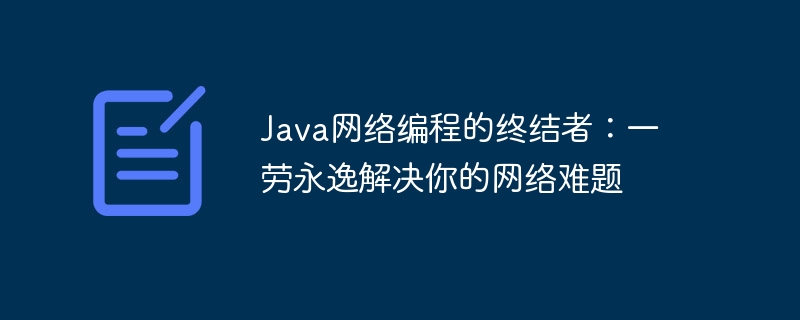
Java network programming has always been a headache for many developers, but now there is a terminator-level tool that can solve related problems once and for all. PHP editor Youzi will reveal this magical tool to you, allowing you to easily cope with various network programming challenges. There is no need to worry about network connection, data transmission and other issues. Stable and efficient network communication can be achieved with just a few simple steps. Let’s explore this Java network programming terminator together and unlock more network development possibilities!
Network connection problem
-
Unable to connect to the server: Check the firewall settings to ensure that the Java application is allowed to access the network. Verify that the server is running and listening for incoming connections.
-
Connection timeout: Increase the connection timeout to accommodate slow or unstable network connections. Consider using non-blocking io or asynchronous programming to improve connection responsiveness.
-
Socket exception: For example, java.net.SocketException may be caused by an invalid address, port or network problem. Double-check the network configuration and application code.
Data transmission problem
-
Data loss or corruption: Use a reliable protocol (such as tcp) to transmit data, and consider using checksums or messages to verify the integrity of the data.
-
Low transmission efficiency: OptimizeNetwork buffer size and use compression technology to improve data transmission efficiency. Consider using non-blocking IO or asynchronous programming to improve throughput.
-
Data Latency: Identify network bottlenecks and take steps to reduce latency, such as using a CDN or optimizing server infrastructure.
Security issues
-
Unencrypted communication: Use SSL/TLS protocol to encrypt network communication to prevent data from being eavesdropped or tampered with.
-
Cross-site scripting (XSS): Validate user input and use appropriate encoding techniques to prevent malicious scripts from being injected into the application.
-
SQL injection: Use parameterized queries and input validation to prevent attackers from injecting malicious sql statements into the database.
Concurrency issues
-
Thread safety: Use synchronization mechanisms (such as locks and semaphores) to ensure threads safe access to shared resources.
-
Deadlock: Identify and break deadlock conditions, such as using timeouts or fair locks.
-
Hungry: Ensures that all threads have a chance to acquire resources, such as by using the fair scheduling algorithm .
Other FAQ
-
Port Conflict: Check whether the port used by the application conflicts with other applications or system components.
-
Network Adapter Issues: Make sure the network adapter is properly configured and active.
-
JVM Configuration: Adjust JVM memory and thread pool settings to optimize the performance of network applications.
solution
The key to solving Java network programming challenges is to take a comprehensive approach, including:
- Thoroughly test the network configuration during development and deployment phases.
- Use reliable protocols and network libraries and protect against security issues.
- Implement appropriate concurrency mechanisms and optimize the use of network resources.
- Regularly Monitor and troubleshoot network applications to identify and resolve any potential issues.
By following these principles and adopting the solutions provided in this article, developers can confidently build reliable and efficient Java network applications that effectively solve network challenges.
The above is the detailed content of The Terminator of Java Network Programming: Solve Your Networking Problems Once and for All. For more information, please follow other related articles on the PHP Chinese website!






